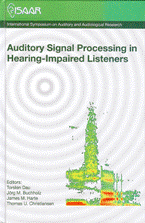Effect of talker variability on speech perception by elderly people in reverberation
Abstract
It has been reported that elderly people have much more dif culty in perceiving speech in reverberation compared to young people with normal hearing. This study investigated how characteristics of talker's speech affected speech perception of elderly people in reverberation to find speech materials that are easier to hear for elderly people in reverberation. In order to simulate various characteristics of talkers’ speech, sentences were produced by people who have received speech training or not with different speaking rates and styles. Stimuli were prepared by convolving the sentences with impulse responses from rooms, and nonsense word identification test was carried out with Japanese elderly people in a diotic listening condition. The results of this study would provide some characteristics of speech materials that are robust to reverberation for elderly people, and those characteristics would be particularly useful in the situation where perfect speech communication is required such as listening to a speech alarm.
References
Arai, T., Nakata, Y., Hodoshima, N., and Kurisu, K. (2007). “Slow speech with steady-state suppression to improve intelligibility in reverberant environments,” Acoust. Sci. Tech., 28, 282-285.
Caissie, R., Campbell, M. M., Frenette, W. L., Scott, L., Howell, I., and Roy, A. (2005). “Clear speech for adults with a hearing loss: Does intervention with communication partners make a difference,” J. Am. Acad. Audiol., 16, 157-171.
Hodoshima, N., Arai, T., Kusumoto, A., and Kinoshita, K. (2006). “Improving syllable identification by a preprocessing method reducing overlap-masking in reverberant environments,” J. Acoust. Soc. Am., 119, 4055-4064.
Nábělek, A. K., and Robinson, P. K. (1982). “Monaural and binaural speech perception in reverberation for listeners of various ages,” J. Acoust. Soc. Am., 71, 1242-1248.
Payton, K. L., Uchanski, R. M., and Braida, L. D. (1994). “Intelligibility of conversational and clear speech in noise and reverberation for listeners with normal and impaired hearing,” J. Acoust. Soc. Am., 95, 1581-1592.
Picheny, M. A., Durlach, N. L., and Briada, L. D. (1986). “Speaking clearly for the hard of hearing II,” J. Speech Hear. Res., 29, 434-446.
Praat Homepage (Version 4.3.04): http://www.praat.org.
Sommers, M. S. (1997). “Stimulus variability and spoken word recognition. II. The effects of age and hearing impairment,” J. Acoust. Soc. Am., 101, 2278-2288.
Additional Files
Published
How to Cite
Issue
Section
License
Authors who publish with this journal agree to the following terms:
a. Authors retain copyright* and grant the journal right of first publication with the work simultaneously licensed under a Creative Commons Attribution License that allows others to share the work with an acknowledgement of the work's authorship and initial publication in this journal.
b. Authors are able to enter into separate, additional contractual arrangements for the non-exclusive distribution of the journal's published version of the work (e.g., post it to an institutional repository or publish it in a book), with an acknowledgement of its initial publication in this journal.
c. Authors are permitted and encouraged to post their work online (e.g., in institutional repositories or on their website) prior to and during the submission process, as it can lead to productive exchanges, as well as earlier and greater citation of published work (See The Effect of Open Access).
*From the 2017 issue onward. The Danavox Jubilee Foundation owns the copyright of all articles published in the 1969-2015 issues. However, authors are still allowed to share the work with an acknowledgement of the work's authorship and initial publication in this journal.


